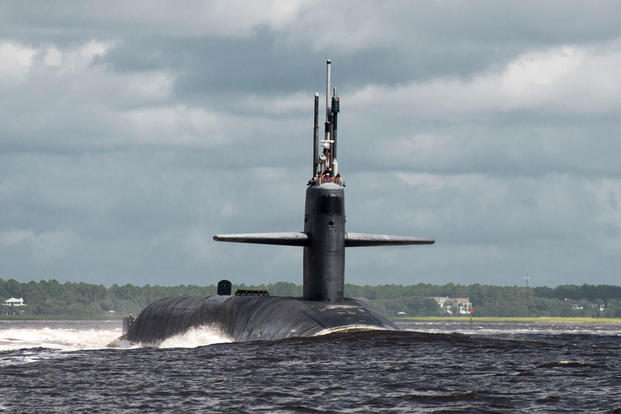The Navy received the largest boost of any of the services in the Pentagon's 2016 budget proposal announced Monday as the Navy looks to buy two new Virginia-class submarines, refuel the George Washington aircraft carrier and offer increased sea pay to its sailors, amongst other initiatives.
The Navy's 2016 budget request asks for $10 billion more than last year to pay for increases in shipbuilding, research, operations and maintenance, readiness and personnel. Overall, the Navy's budget proposal is $160.9 billion.
"Across the full scope of the request there was a strong focus on innovation and reform," said Adm. William Lescher, Deputy Assistant Secretary of the Navy, Budget.
Sailors would receive an across the board 1.3 percent pay raise like the rest of the U.S. military under the proposed budget as well as extra money for increases in sea pay, critical skills pay and hardship duty pay for sailors on extended deployments.
Alongside the increased funding for Navy and Marine Corps personnel -- which jumped from $43 billion to $46 billion this year, the Navy budget also includes an increase in operation and maintenance funds.
The 2016 operations and maintenance request increased from $50 billion over roughly $45 billion in last year's request. Service officials described the increase as a needed measure to reset the maintenance backlog caused by the high operational tempo over the last decade.
"We're asking for more funding to get us back up to speed with our maintenance and depot levels. We are thinking about everything we need and we are trying to put our money toward what increases our presence the most," a Navy official said.
Shipbuilding is also an area where there is a slight increase in this year's budget request. The Navy plans to buy nine ships in 2016 to include $3.2 billion for two new DDG 51 Arleigh Burke-Class destroyers, $5.3 billion for two new Virginia-class attack submarines, $1.4 billion for three Littoral Combat Ships and one new amphibious transport dock or LPD 17.
Lescher said the Navy will deliver 14 ships and retire three, bringing the total fleet size up to 282 ships in 2016. The fleet will reach 304 ships by 2020, Lescher said.
The budget proposal specifies $2.5 billion for the Navy's new Ford-class aircraft carriers.
The Navy's first Ford-class carrier, the USS Gerald R. Ford, was christened in 2013. The ship is slated to enter service and be formally commissioned next year. Meanwhile, the service's second Ford-class carrier, the USS Kennedy, is now under construction at Newport News Shipyard, Virginia. The shipyard is a part of a facility owned by Huntington Ingalls Industries.
Navy leaders included $693 million in funding to refuel the USS George Washington aircraft carrier. The George Washington is slated to go through a mid-life nuclear refueling and overhaul process which would ensure the platform can serve out the remaining 25 years of its service life.
Navy leaders said last year that the across-the-board budget cuts known as sequestration would force the service to rescind funding for the refueling of the George Washington. This move would have retired the George Washington at the half-way point of its career and reduced the number of carriers operated by the Navy from 11 down to 10.
The Navy has said that this year's budget request includes an emphasis upon ensuring the size of the fleet remains at 11 aircraft carriers.
Also, the fiscal 2016 proposed budget includes $2.2 billion across the five-year spending plan for a nuclear enterprise review. This includes nuclear fueling for ships and submarines along with nuclear facilities maintenance and upkeep at shipyards, service officials said.
A new aspect of this year's budget for the Navy includes funds for the newly announced Task Force Cyber Awareness, or TFCA. TFCA is a 100-person force dedicated to establishing protocols, identifying vulnerabilities, increasing cyber awareness and shoring up security and access with the Navy's computer networks, service leaders explained. In total, the Navy's 2016 budget request asks for $300 million for various cyber security initiatives.
In terms of research and development, the budget directs $67.4 million for directed energy weapons and $242 million for a next-generation radar technology called Air and Missile Defense Radar, or AMDR.
The 2016 budget also includes $1.4 billion in funds for the Ohio Replacement program – a program to develop a next generation Ohio-class nuclear submarine. Separate from this budget proposal is the new fund designed by Congress to provide money for the Ohio Replacement program in order to separate the program from the shipbuilding budget. Called the National Sea-Based Deterrence Fund, the effort seeks to identify and gather funding to pay for the program without further draining the Navy's existing shipbuilding budget.
Lescher explained that the Navy's budget request includes roughly $5 billion across five years for advanced procurement for the Ohio Replacement program and $5 billion for research and development. Additional funds will be needed, however, when the first Ohio Replacement submarine is built in 2021, Lescher added.
"They are the top programmatic priority of the department. They will get built," Lescher said.
Although there are not yet any identified funds allocated for the account, lawmakers and Navy leaders have said they want to find a way to ensure funding for the national strategic priority of undersea nuclear deterrence without compromising the Navy's other shipbuilding priorities.
"Our view of the deterrence fund is that it is a great first step in bringing recognition of the challenge," Lescher added.
-- Kris Osborn can be reached at kris.osborn@military.com





























